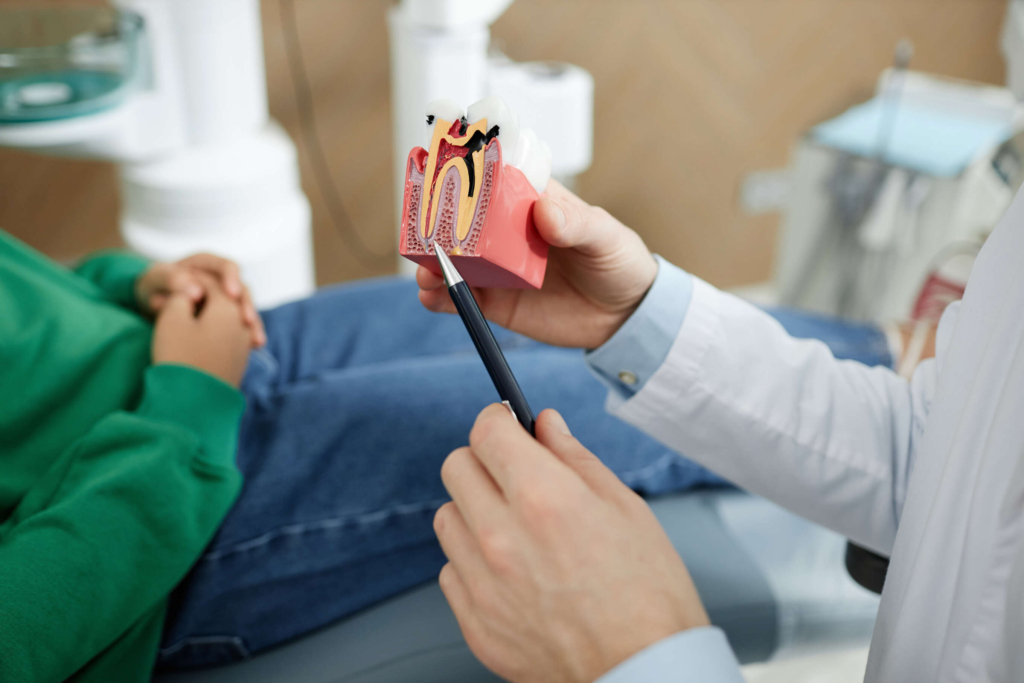
Toothaches can be excruciating, disrupting your daily life and causing significant discomfort. While cavities and minor injuries are often treatable with simple fillings, more severe damage sometimes necessitates a root canal.
This article explores the purpose and process of root canal therapy, a procedure offered by Como Lake Village Dental, your trusted dentist in Coquitlam, BC. Understanding what a root canal does and the signs that you might need one can empower you to make informed decisions about your oral health.
The Role of the Tooth Pulp
The core of your tooth, beneath the white enamel and dentin layers, is the pulp. This soft tissue houses nerves, blood vessels, and connective tissues, playing a crucial role in tooth development and sensation.
However, the pulp can become compromised due to various factors, including:
- Deep cavities: If left untreated, cavities can burrow into the inner layers of the tooth, reaching the pulp.
- Cracked or chipped teeth: Cracks or chips can expose the pulp to bacteria, leading to infection.
- Repeated dental procedures: In some cases, multiple procedures on the same tooth can irritate the pulp.
When Does a Root Canal Become Necessary?
When the pulp becomes inflamed or infected, it can cause significant pain, sensitivity, and swelling. These symptoms are a signal that the pulp is no longer healthy and needs intervention.
Here are some common signs that a root canal might be necessary:
- Persistent toothache: A throbbing or sharp pain in a particular tooth, especially at night or when applying pressure, can indicate pulp damage.
- Increased tooth sensitivity: Sensitivity to hot, cold, or sweet foods and beverages can be a sign of irritation or inflammation within the tooth.
- Swollen gums: Gum inflammation or swelling around the affected tooth can accompany a root canal infection.
- Visible pimple on the gum: In severe cases, an abscess (pimple) containing pus may form on the gum near the infected tooth.
If you experience any of these symptoms, it’s crucial to seek professional dental help promptly. Early diagnosis and treatment can prevent further complications, such as bone loss around the tooth or the spread of infection.
How Does Root Canal Therapy Work?
The primary purpose of root canal therapy is to save a tooth by removing the infected or inflamed pulp. Here’s a breakdown of the typical root canal procedure:
- Local anesthesia: The dentist will administer an anesthetic to numb the area around the tooth, ensuring your comfort throughout the procedure.
- Creating access: The dentist will create a small opening in the crown of the tooth to access the pulp chamber.
- Removing the pulp: Using specialized instruments, the dentist will carefully remove the infected or inflamed pulp tissue.
- Cleaning and disinfecting: The canals within the root system will be thoroughly cleaned and disinfected to eliminate any remaining bacteria.
- Sealing the tooth: After ensuring the canals are clean and infection-free, the dentist will fill them with a special material to prevent future problems.
- Placing a crown: In most cases, a dental crown will be placed on the treated tooth to restore its strength, functionality, and aesthetics.
Como Lake Village Dental utilizes advanced techniques and equipment to ensure your root canal therapy is performed with precision and comfort.
Their team of highly skilled dentists prioritizes patient well-being and will take the time to explain the procedure, answer your questions, and address any concerns you may have.
Benefits of Root Canal Therapy
While the idea of undergoing dental procedures might seem daunting, root canal therapy offers several significant benefits:
- Preserves the natural tooth: By removing the infected pulp and sealing the tooth, root canal therapy saves the natural tooth structure, allowing it to function normally and maintain its position within the jawbone.
- Eliminates pain and infection: The procedure effectively addresses the source of the pain and infection, providing relief from discomfort and preventing further complications.
- Restores oral health and function: A root canal-treated tooth can continue to function normally, allowing you to chew comfortably and maintain good oral hygiene.
- Improves overall well-being: Addressing a dental infection can have a positive impact on your overall health and well-being.
Taking Care of Your Teeth After Root Canal Therapy
Following your root canal procedure, your dentist will provide specific instructions on caring for your treated tooth. Here are some general tips:
- Maintain good oral hygiene: Brushing twice a day and flossing daily are crucial for preventing future problems.
- Follow a balanced diet: Limit sugary and acidic foods, which can contribute to tooth decay.
- Attend regular dental checkups: Schedule regular dental appointments for professional cleanings and examinations to monitor your oral health and address any potential issues promptly.
If you have concerns about whether or not you need a root canal, contact us today at (604) 936-8022.